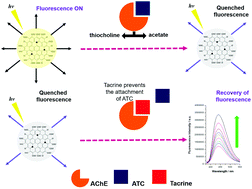Development of a biosensing system for tacrine based on nitrogen-doped graphene quantum dots and acetylcholinesterase†
Abstract
This work presents a novel fluorescent sensor for the determination of tacrine by combining the magnificent fluorescence properties of nitrogen-doped graphene quantum dots (N-GQDs) with the high potential of acetylcholinesterase (AChE) enzyme for screening its inhibitors. Tacrine was the first drug approved for Alzheimer's disease and it is currently being used in several therapeutic treatments given its activity as a reversible inhibitor of AChE. The principle of the developed biosensor relies on the fact that the native fluorescence of the synthesized N-GQDs is quenched by interaction with enzymatic reaction products, and the inclusion of tacrine in assay solution results in the gradual recovery of the original fluorescence in an inhibitor concentration-dependent manner. While N-GQD fluorescence was not directly affected by tacrine, the inclusion of an AChE based-enzymatic system allowed for its determination with a detection limit (S/N = 3) of 1.22 μM. This biosensor was demonstrated to be simple, rapid and reproducible (%RSD 4.87, n = 7) for analysis of tacrine in aqueous solutions.

- This article is part of the themed collections: Alzheimer's Research Month 2016 and Carbon and graphene in analytical science

 Please wait while we load your content...
Please wait while we load your content...